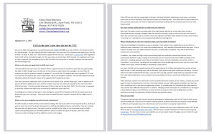 A new report released today by the Campaign for A Better Capital Plan, the Manhattan Taskforce on School Overcrowding, Class Size Matters, the United Federation of Teachers, and The Center for Arts Education concludes that the new five-year capital plan for schools, due to be proposed next week, should aim to eliminate existing overcrowding and reduce class size to the levels in the city’s state-mandated class size plan, be proactive in planning for growth, and create enough space for arts, science and other activities needed for a well-rounded education.
A new report released today by the Campaign for A Better Capital Plan, the Manhattan Taskforce on School Overcrowding, Class Size Matters, the United Federation of Teachers, and The Center for Arts Education concludes that the new five-year capital plan for schools, due to be proposed next week, should aim to eliminate existing overcrowding and reduce class size to the levels in the city’s state-mandated class size plan, be proactive in planning for growth, and create enough space for arts, science and other activities needed for a well-rounded education.The DOE and School Construction Authority (“SCA”) should be able to explain, in detail, how a fully funded capital plan would be able to achieve all of these objectives, phased in over a reasonable amount of time– not just as citywide or district averages, but in every neighborhood in the city.
Among the findings of the report, “A Better Capital Plan”:
- Based on the DOE’s own data, approximately 167,842 new school seats would be necessary to eliminate trailers and other temporary spaces, relieve overcrowding and reduce class size to the goals in the city’s state-mandated class size reduction plan. The cost of creating these seats would raise the estimated share of the city’s capital spending on schools to 20% -- still significantly below the 23% average during the period 2000-2007. The report includes a breakdown of the need for seats by school type, borough and district.
- The capital plan should prepare for growth by incorporating a neighborhood analysis of housing starts, birth data, pre-K enrollment and other information to more accurately project future enrollment and capacity needs. Already, there are signs that enrollment citywide will not continue to decline indefinitely. Kindergarten enrollment has risen two out of the last four years, the DOE’s budget projections show no drop in the number of Kindergarten students, elementary schools grew more overcrowded last year, and City Planning predicts an increase in the number of 5-9 year olds over the next ten years.
- The methodology for calculating school utilization should be completely revised, by aligning it to the city’s class size goals and by more accurately assessing the need for dedicated spaces for art, science, libraries, cafeterias and gyms and special services. This will require a new reporting process that involves administrators, educators and parents at the school level.
So can we afford to build enough schools, in the midst of this economic meltdown? As Patrick Sullivan, representative to the Panel on Educational Policy and co-chair of the Manhattan Taskforce on School Overcrowding said:
“In his recently published letter to the president-elect, Mayor Bloomberg asserts that ‘a bold infrastructure plan will help put Americans back to work.’ Before we urge others to take action, we need to lead by example and make the most important infrastructure investment there is -- schools to educate our children. For too long school construction in
Here is an article in today’s Daily News about the report’s findings: City classrooms packed, expansion slows in Mayor Bloomberg era ...
According to Gotham Schools, Joel Klein’s response to the report today was to claim (inaccurately) once more that this was “the most robust capital plan the city has ever seen.”















No comments:
Post a Comment